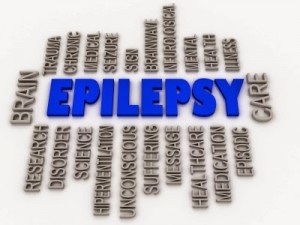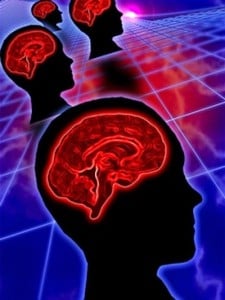 Epilepsy is a group of neurological disorders characterized by the recurrence of seizures. Many different types of epilepsy exist, all having various different causes and symptoms. When the brain experiences abnormal electrical discharge from cortical neurons, this causes seizures occur. There are six different types of generalized seizures.
Epilepsy is a group of neurological disorders characterized by the recurrence of seizures. Many different types of epilepsy exist, all having various different causes and symptoms. When the brain experiences abnormal electrical discharge from cortical neurons, this causes seizures occur. There are six different types of generalized seizures.
- Absences, also known as petit mal seizures, typically occur in children ages 4 to 14, and cause a short incident of “blanking out” where the person appears to be staring into space. For the sufferer, they become unaware of their surroundings and become unresponsive to communication. When the seizure ends, they go about their day as usual, as if nothing had occurred. These seizures can occur simultaneously with other types of seizures. There are two main types of absences, simple and complex. Simple absences happen so quickly they are hardly noticeable. Lasting only less than 10 seconds, people often confuse this behavior with daydreaming. Complex absences can last up to 20 seconds and provoke the sufferer to move in some way as they become vacant, including blinking, chewing, and hand movements. Because these seizures are difficult to identify, the first sign is when a child starts struggling in school.
- Atonic seizures are characterized by sudden loss in muscle strength, and can occur in both adults and children, often beginning in childhood. The person typically remains awake and alert, but signs like inability to hold objects, uncontrolled head nodding, and even falling to the ground occur. These seizures can occur just one at a time or many times in a row. The seizure normally lasts less than 15 seconds, however, atonic seizures can cause significant injury.
- Clonic seizures get their name from the word “clonus”, meaning quick alternation between muscles contracting and relaxing. When one of these seizures occur, the person experiences rapid, rhythmic jerking movements in both the arms and legs, which can occur on one or both sides of the body. When the seizure ends, the person normally does not suffer injuries and can continue as they were before the seizure. Clonic seizures occur at a variety of ages. Short and infrequent clonic seizures are typical in infants. However, despite how alarming it may be to witness an infant experiencing this seizure, they often go away on their own without a need for treatment as the infant develops.
- Myoclonic seizures are quick 1-2 second seizures that cause muscle jerking as the sufferer is conscious and aware. They are typical in a variety of epileptic syndromes for various ages, but they most often begin during childhood. Myoclonic seizures can also occur in people without epilepsy from time to time as well. They can occur in groups or even just once in a while. Much like the absence seizures, they often go overlooked as people attribute the behavior to commonly known behaviors. In the case of myoclonic seizures, people often mistake the seizure for physical manifestations like tics or tremors. No medical attention is needed post-episode, and the sufferer usually resumes their previous activity.
- Tonic seizures are particularly common for the epilepsy syndrome known as Lennox-Gastaut Syndrome, however they can occur in anyone. The seizure causes the muscles to stiffen forcefully and the body begins make sudden, rigid movements on both sides for about 20 seconds or less. They are known to occur most often during sleep, however they can happen when a person is awake, causing them to fall to the ground, increasing the risk for injury. After a tonic seizure, sufferers are often tired and confused.
- Tonic-clonic, known as gran mal, combines the occurrence of the tonic an clonic seizures lasting roughly 1 to 3 minutes. If they last longer than 5 minutes, seeking immediate medical attention is urgent. At first, the tonic portion of the seizure begins as the muscles stiffen, causing the person to drop to the floor unconscious. Often times, a groan can be heard from the person before the fall as the air passes the vocal cords with force. Injuries can occur from biting inside the mouth as well. As the clonic portion of the seizure begins, the limbs begin to jerk quickly and rhythmically for a few minutes until finally the motions slow and stop. The seizure may cause loss of bowel control as well. The person becomes conscious again slowly and confusion often occurs. Both adults and children have been known to suffer tonic-clonic seizures.
How Neurofeedback Can Help
Once diagnosed, epilepsy is commonly controlled by anti-seizure medication. Epilepsy can also be treated using neurofeedback in conjunction with medication, or when medication is unable to produce the desired results.
Research regarding the use of neurofeedback for epilepsy dates back to the 1960’s with Dr. Barry Sterman’s discoveries. Epilepsy was the first disorder to be treated with these newly discovered methods. Neurofeedback has been proven to raise a person’s seizure threshold, meaning the brain would be more resistant to seizures. Intractable seizures, those that cannot be controlled by medications, can be corrected using neurofeedback. A reduction in frequency, intensity, and recovery time has resulted from the method as well. Additional issues arise in the brain due to epilepsy, including reduced cognitive efficiency, affecting processing speed and memory. Neurofeedback is also able to address and correct these brain functions.
A highly important part of treatment for epilepsy, it is often considered first choice because it can lead to overall improved function, improvement of the effects of medication, and/or a reduction or complete elimination of medication. Neurofeedback is safe for both children and adults, and it the positive results have been proven to last.
“Based on this meta-analysis, EEG operant conditioning (neurofeedback) was found to produce a significant reduction on seizure frequency. This finding is especially note-worthy given the patient group, individuals who had been unable to control their seizures with medical treatment.”
-Tan, ET AL 2009
Journal of Clinical EEG and Neuroscience
Image courtesy of David Castillo Dominici at FreeDigitalPhotos.net





